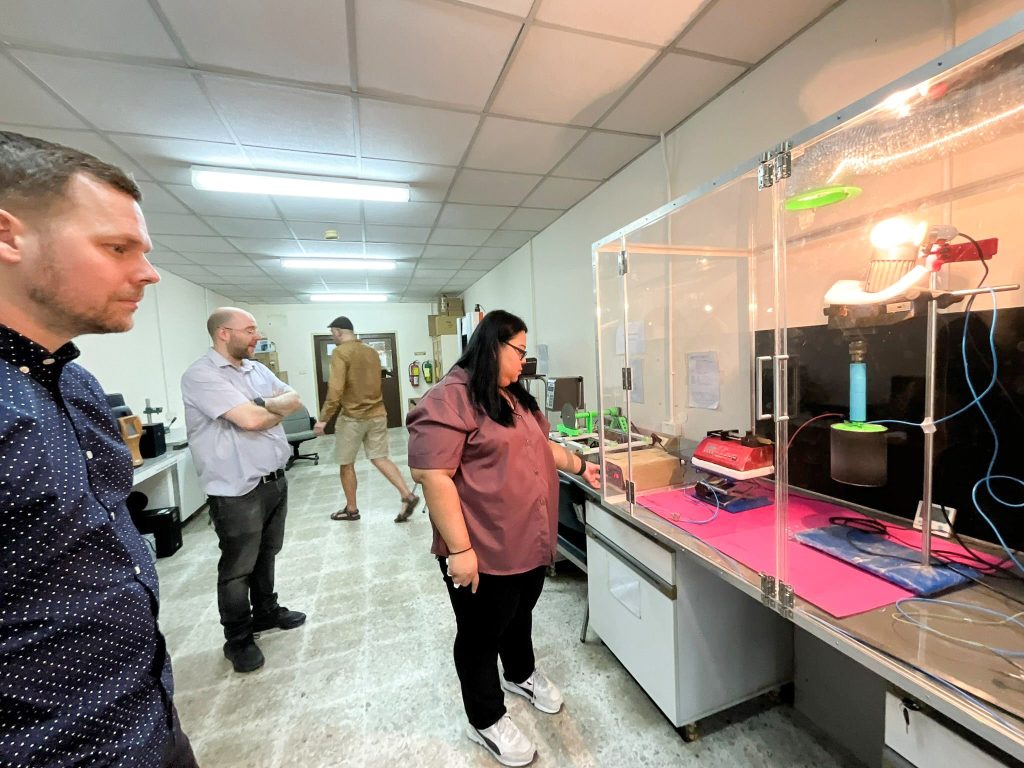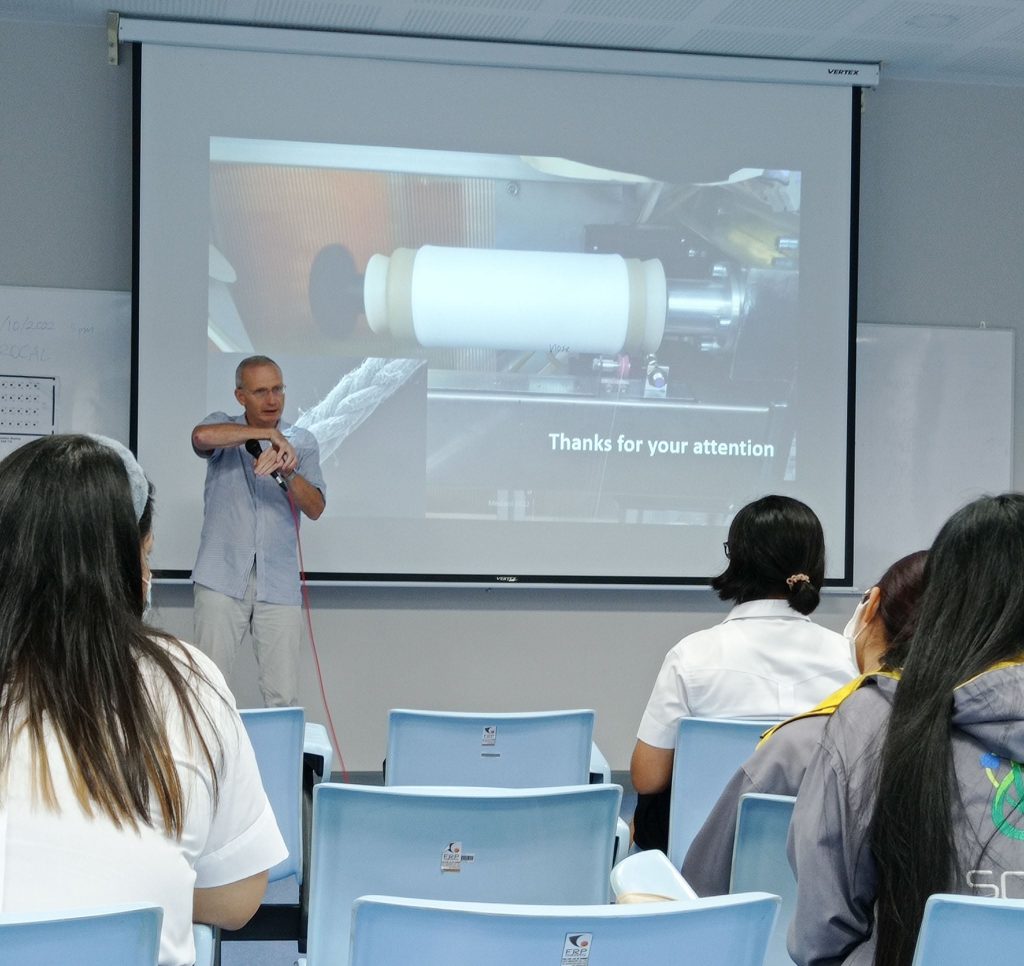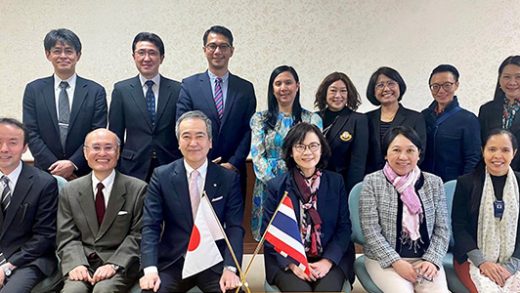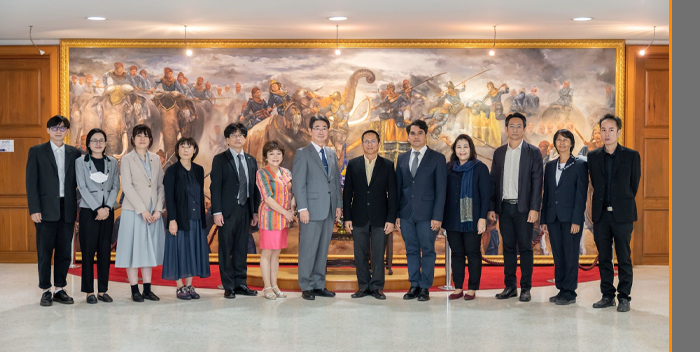Scientists from Naresuan University Sukunya Ross and Gareth Michael Ross, along with Petr Mikeš from the Department of Physics FP TUL at the university’s CXI institute, oversee the production of wound coverings from natural polymers. Photo: Adam Pluhař
Biodegradable fibers from silkworms may soon help heal skin wounds. This is one of the research directions of the prestigious international project Medipol, in which TUL is a participant. The project’s essence is to find new polymeric materials for human skin regeneration and other medical applications. The Technical University of Liberec joined the project, adding to a network of partner universities and workplaces from Europe and Thailand, thanks to its globally recognized know-how in electrospinning polymer solutions.
“Our contribution mainly lies in the transfer of knowledge in nanomaterials. This includes equipment for nanofiber production and their characterization using electrical and optical methods – we can observe polymer networking online or measure the gelation point, we participate in characterizing polymer solutions and their relaxation times, and so on,” explains Petr Mikeš from the Department of Physics at the Faculty of Science, Humanities, and Education TUL (FP), who leads the project for the Technical University of Liberec.
The €1.3 million project is in its fourth year and will conclude this year. The main project leader, funded by the Marie Skłodowska Curie Action Cost program, is Aston University in Birmingham, UK. The network of partner institutions includes several universities from Thailand and an industrial partner from Spain. Thailand has a long tradition in polymer chemistry and extensive experience in using natural polymers.
Searching for New Material Using Natural Resources
Scientists from TUL involved in the project are testing the spinnability of polymer materials with integrated active biological substances. Spinning tests are conducted using both direct and alternating current and by drawing individual fibers, known as the drawing method.
“We try to modify synthetic nanomaterials and use natural resources to create new material. There are many polymers in nature, such as proteins or polysaccharides. We obtain these polymers from Thai colleagues and work with them. The main difficulty is that it is very challenging to maintain standard properties in natural polymers. For example, silk is obtained from silkworm cocoons, and the cocoons we work with never have the same form,” describes Petr Mikeš, one of the research problems, adding, “We have already managed to spin silk in the lab. Our effort now is to maintain the process and transfer everything to industrial production. It has to be stable for a certain period.”
Scientists from TUL involved in the project are testing the spinnability of polymer materials with integrated active biological substances. Photo: Adam Pluhař
Scientists from TUL involved in the project are testing the spinnability of polymer materials with integrated active biological substances thanks to globally recognized know-how in electrospinning polymer solutions. Photo: Adam Pluhař
Research also took place in Thailand. Photo: FP TUL archive
Professor David Lukáš during a lecture in Thailand. Photo: FP TUL archive
The researchers dissolve the mentioned silk and combine it with supportive biodegradable polymers, creating fibers with a diameter of only 200 or 300 nanometers. In contrast, silkworm fibers in nature measure tens of micrometers. “Our finer fibers absorb better, and cells grow better on them,” explains Petr Mikeš.
According to him, what fundamentally distinguishes natural from artificial polymers is their internal structure. “Natural polymers have a vast number of functional groups, are very diverse, and have many advantages. For example, fibers made from natural polymers have better water wettability, which improves adhesion, and cells grow better on them,” says Associate Professor Mikeš.
In the preparation laboratory of the Institute for Nanomaterials, Advanced Technologies, and Innovation TUL, the Nanospider device from Elmarco is currently preparing nanofibers. The researchers are preparing materials that can be used for medical wound coverings. These materials consist of polyesters and natural polymers brought by Gareth Michael Ross and Sukunya Ross, scientists from the Department of Chemistry at the Faculty of Science, Naresuan University, Thailand.
The Project Also Aims at New Contact Lens Production
Professor Ross is also an expert on hydrogels, from which contact lenses are made. The Department of Physics FP TUL plans to expand collaboration with Thai scientists in this area. “We will characterize polymer solutions used for manufacturing hydrogels for contact lenses using optical methods. This will help Thai colleagues get feedback during production using optical and electrochemical methods,” explains Associate Professor Mikeš.
“The project has excellent benefits, mainly due to the mutual collaboration on research utilizing natural resources and biodegradable materials. I am glad that the Technical University of Liberec is involved. It has outstanding results not only in the field of electrospinning,” says Professor Gareth Ross.
The possibility of visiting research workplaces of collaborating parties is another significant benefit of the project. Many colleagues from across FP and the entire university have traveled to Thai universities over the four years. “Academic trips have always been associated with knowledge and skills transfer to the receiving workplaces in this project. Experts across fields are also training each other through online webinars throughout the project’s duration. Our academics and doctoral students have even helped create special devices for laboratory production of polymer nanofibrous materials, which were lacking at Thai universities,” says Eva Kuželová Košťáková, Vice Dean of FP TUL for Internationalization and Doctoral Studies.
Adam Pluhař
Many colleagues from across FP and the entire university have traveled to Thai universities over the four years. Photo: FP TUL archive
Not only scientific work but also culinary experiences awaited TUL scientists during their stays in Thailand. Photo: FP TUL archive
Meetings at the Thai university. Photo: Naresuan University archive
Submitted by: adam.pluhar, 27. 5. 2024
Original news story is linked below:


![]()




